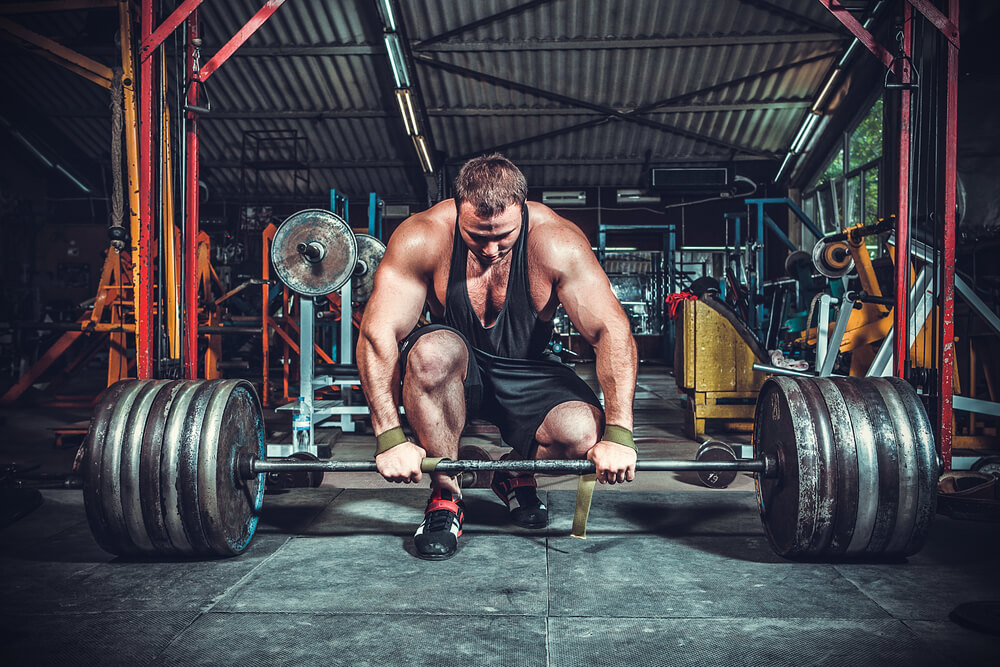
When working out, people will often tell you more work is done on your muscles during that final rep where you struggle to put it up than the rest of the reps combined.
Why?
Well, naturally, you still need to pump out those initial reps in order to reach the point of failure, but on that final rep, where it feels like you’re pushing against a brick wall, it places your muscles under tension. It’s like when you try to move something that you can’t.
Your muscles swell with blood and you may even feel sore after the effort, all without moving the object at all (even if it’s that frustrating jar of pickles that just doesn’t want to open).
Time under tension does more than just get your blood pumping and your veins popping for a few moments. It can actually help you build larger muscles.
You just need to know how to take advantage of it.
What Does Time Under Tension Mean?
When you pump out a set, how long does that take you?
Depending on how fast you perform every lift, maybe anywhere from 15 to 30 seconds, right?
However, how much time are your muscles actually under strain?
This is the time during the lift and, if you’re using free weights, the time you lower the weights back down.
There is also a third option, which is complete tension training (we’ll get into that in a little bit). The top and bottom portion of your lift is usually not tension heavy, although there are some exceptions to this rule (take, for example, if you’re benching with dumbbells and you hold the weight without touching your chest on the bottom as this will place added tension on your chest and triceps because there is no rest).
Ideally, for the best workouts you’ll have more time under tension. If you’re blowing through a set of 10 in 15 seconds you’re not putting all that much tension on your muscles. It may end up equating to around 10 seconds.
If you slowed down, you could up this to 30 seconds.
By tacking on just a short amount of time you increase the tension on your muscles, which causes the muscle fiber to break down faster and, in return, build up larger .
How to Lift Focusing on Time Under Tension
First, ditch all machines.
Machines will not help you when it comes to tension. This is because the machine will often do the work during the eccentric portion of the lift.
For example, if you’re using a preacher curl machine, you lift up into your biceps using your own tension.
However, the machine assists you lowering the weight down (or does the work for you). This kills our eccentric gains.
You could be hitting both your biceps and triceps at the same time, and by slowing down the lift, you extend the time under tension and place more stress on the muscles. The machine instantly removes half of this.
So if at all possible, ditch the machines for free weights.
Now, in order to lift with time under tension in mind you want to maximize the amount of time your muscles are under tension and reduce the amount of rest time.
The best way to do this is to shoot for tempo. You can do this by counting in your head or with breaths.
For example, take a count of two to push the weight up (if, in this case, you’re doing a bench press), then let the weight down slowly at a count of four.
The beauty of lifting like this is you put tension on your main muscle for the two seconds, and the eccentric element of your lift receives twice as much attention, which will not affect the main portion of the lift.
Basically, you’re turning your lift into a double lift.
When performing a chest press all the added time spent going down works your shoulders and back, allowing you to really blast just about your entire upper body while putting it all under extended tension.
When focusing on time under tension it is extremely important to focus on your form. You are elongating your move.
Instead of putting up one lift that might take one second, you’re slowing it down and taking six. If your form is bad you open yourself up to all sorts of problems and injuries.
It is far better to lower your weight to ensure expert form than to try and go overboard with the weight and injure yourself.

It Still Needs to Challenge You
When lifting with a focus on tension during the reps you still need to make sure it is a challenge. You can’t drop down the weights, blast through your reps and assume you’ll begin seeing muscle growth.
Even if you need to lighten the load a bit in order to accommodate the extended lift time, you need to lift to failure, just like you would with any other lift.
You should still shoot for that eight to 12 rep per set number for maximum muscle growth.
You’re just compounding the effort by incorporating tension as well.
When you lift to failure while bringing in tension, you’re doing more damage to your muscles and opening up the possibility for more muscle growth than by just focusing on one method or the other.
Total Tension
This is something to toss on to the end of your workout. It’ll take your time under tension and put it over the top to 100 percent. You’ll need to pick out specific weights and lifts for this as it won’t work for all lifts. It’s also a good way to end your workout.
With total tension, you select a weight you can’t possibly lift.
So say you normally curl 25 or 30 pound dumbbells. Pick out 60 pound dumbbells. Position yourself in an area where you can’t injure yourself (you can overload a preacher curl with this as well, as it places added support on your joints).
Now, put everything into trying to lift it while maintaining form.
You won’t be able to, but that’s the point. Do this for 10 seconds or so. You’re muscles will fully engorge with blood and the tension will add increased tearing to your muscles.
Do this three times for each lift you’re able to do it with.
With this total tension “lift” you’ll be completely amazed as to how blasted your body feels after attempting it. It’ll tap out the last remaining amount of energy you have. Just make sure to only do this with lifts where you are safe and you won’t injure yourself.
Naturally you shouldn’t load up a shoulder squat.
However, you can load up a leg press. In these instances it is alright to use a machine (especially if you can’t lug around hundreds of pounds of weights to a given area of the gym). Overload the machine and put everything you’ve got into it.
For the 10 seconds you put into the attempt you not only achieve 100 percent time under tension but you don’t have any breaks in it either.

Shifting Weight
When you lift you can start out with the same amount of weight you normally would have before you started to bring time under tension into the fold.
However, with the added amount of time you’ll quickly discover you burn through more energy. Because you’re blasting through your energy on the reps you’ll discover you are not able to put up as many reps with each set. You don’t want to just put up two or three reps during your final sets.
After all, the goal is for muscle growth and to achieve this you need to push for that 8 to 12 range. In order to do this you’ll need to shift how you’re adding and reducing weight.
Prior to adding a focus of tension into the lift you likely added weight with every step in order stay in the target zone.
But now, you’ll need to reduce weight, which is perfectly fine. It’s okay to take a few pounds off of your curls with every subsequent rep.
While you’re not lifting as much you’re putting more tension on the weight which rips the muscle tissue further and helps you along with your size gains.
So while you will be changing the way you add and remove weights on your lifts it is all to help with increasing size.
Be Mindful Of Your Body
It is important to listen to your body as you lift. Even if the amount of weight you’re lifting changes it places more tension on it.
Naturally, you want the added tension on your muscles but the added tension on joints may not be something you’re interested in. If you have bad knees or shoulders it is especially important to pay attention to your body reacts.
Are your joints extra sore after these kinds of workouts?
If so, you may want to avoid the tension workouts for the joints affected.
The added tension forces your muscles to remain engaged and bent for longer periods of time. This in turn also places more tension on the ligaments connecting muscles and bones around a joint.
If you are coming off of surgery or you commonly feel pain in these areas it usually is because of the added stress placed on the ligaments and tendons.
In these instances you should avoid adding in the time under tension element to your lifts.
However, you are still able to perform the maximum tension “lifts.” While you’re putting your muscles under constant stress you actually are not placing tension on the joints because your joints are not fully engaged and not supporting your body under the weight as you don’t have the weight physically lifted.
So while you might not be able to utilized time under tension for the rest of your workout you are still able to take advantage of this aspect.
Plus, because it is possible to perform the maximum tension lifts on machines you will have added padding and support.
If you are coming off of ligament surgery (such as an ACL or rotator cuff) make sure to talk with your doctor about the right kind of workout for you. They will want you to start off with lower weights when you do begin.
Ask about taking advantage of low weight time under training. Because you are not putting as much weight on the joints they may approve of this before moving on with heavier alternatives.

Always Switch Up Your Workouts
Over time your body will adapt to the way you lift. When this happens your potential gains drop and you won’t experience the same kind of results.
One of the reasons for adding tension to your lifts is to jumpstart the muscle building process. If or when you begin to experience another slow down you can move back to heavier lifts without the tension.
Moving back and forth every few weeks while using different moves keeps your body off balance and your muscles constantly building.
Conclusion
There are a number of ways you can build muscle. Generally this is done with a combination of weight and reps. However, your body adapts to how you lift and eventually will prevent you from building on any more.
Due to this you need to use a different technique. Time under tension is such a technique, but you don’t need to wait until you’ve maxed out using the other lifting methods.
By taking advantage of tension training you’ll force your muscles to remain fully engaged for a longer period of time, which helps break down more muscle tissue.
While you don’t want to have a workout completely made up of tension, adding in tension lifts and moves at the end of your workout does have the ability to take your muscle building and form defining to the next level.
Terry Asher
Latest posts by Terry Asher (see all)
- Better Family – Product Review Liquid Daily 2 oz - Dec 16, 2024
- Post-Workout Recovery: The Key to Optimal Performance - Nov 25, 2024
- Pre-Workout Supplements – Everything You Need To Know - Nov 18, 2024









[…] Source link […]
[…] post Time Under Tension: What’s It All About? appeared first on Gym […]
[…] Read more Here | 2018-08-29 15:00:59 Image credit: source Facebook Twitter Google+ Pinterest […]
Thank you for sharing this useful information, I will regularly follow your blog
[…] 1, 2018 Facebook Twitter Google+ Pinterest […]
[…] post Time Under Tension: What’s It All About? appeared first on Gym […]
[…] that can be applied throughout the whole exercise, spider curls are a favorable biceps exercise. Time under tension is the time during the lift and, if you’re using free weights, the time you lower the weights […]
[…] that can be applied throughout the whole exercise, spider curls are a favorable biceps exercise. Time under tension is the time during the lift and, if you’re using free weights, the time you lower the weights […]
[…] that can be applied throughout the whole exercise, spider curls are a favorable biceps exercise. Time under tension is the time during the lift and, if you’re using free weights, the time you lower the weights […]
[…] only that, but there is also very little tension in the glutes with this exercise. By limiting the gluteus maximus or the butt as we know it, it […]
[…] only that, but there is also very little tension in the glutes with this exercise. By limiting the gluteus maximus or the butt as we know it, it […]
[…] only that, but there is also very little tension in the glutes with this exercise. By limiting the gluteus maximus or the butt as we know it, it […]